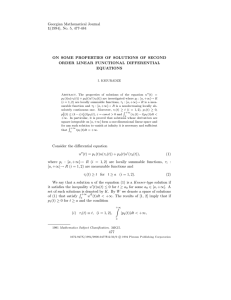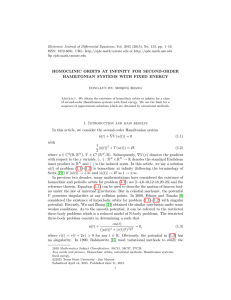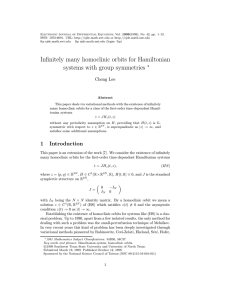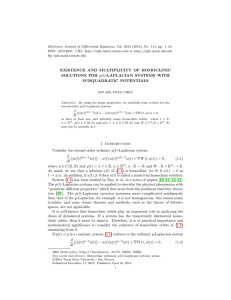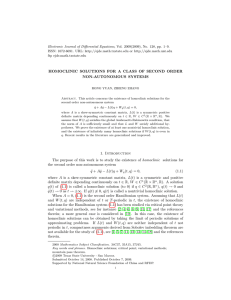Document 10747563
advertisement
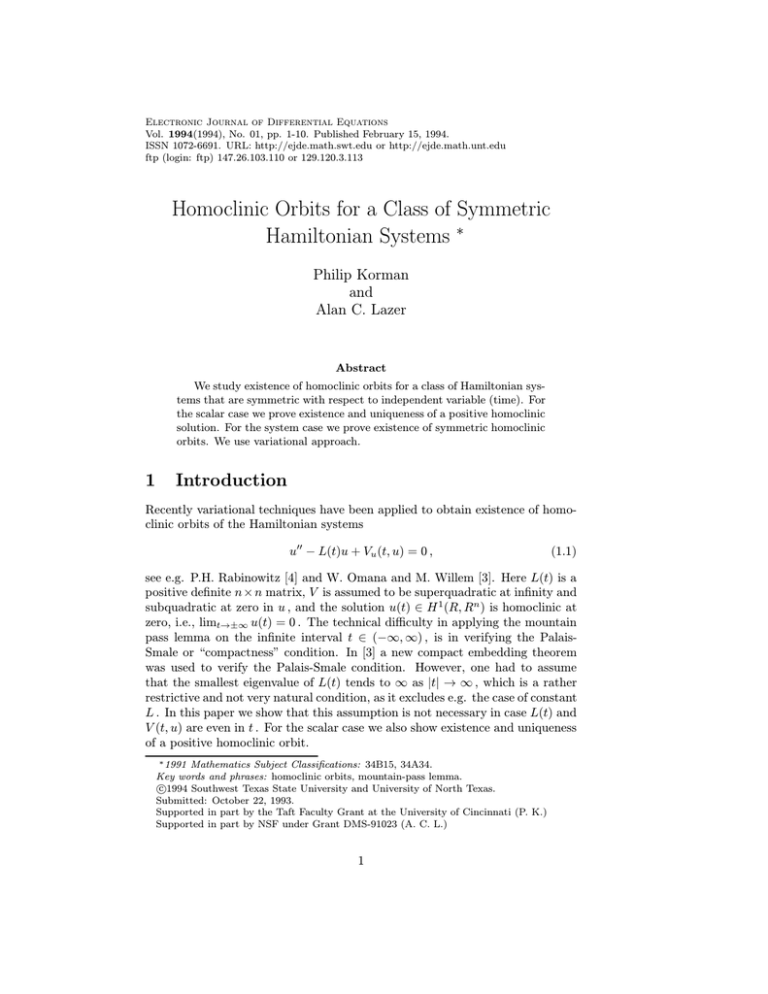
Electronic Journal of Differential Equations
Vol. 1994(1994), No. 01, pp. 1-10. Published February 15, 1994.
ISSN 1072-6691. URL: http://ejde.math.swt.edu or http://ejde.math.unt.edu
ftp (login: ftp) 147.26.103.110 or 129.120.3.113
Homoclinic Orbits for a Class of Symmetric
Hamiltonian Systems ∗
Philip Korman
and
Alan C. Lazer
Abstract
We study existence of homoclinic orbits for a class of Hamiltonian systems that are symmetric with respect to independent variable (time). For
the scalar case we prove existence and uniqueness of a positive homoclinic
solution. For the system case we prove existence of symmetric homoclinic
orbits. We use variational approach.
1
Introduction
Recently variational techniques have been applied to obtain existence of homoclinic orbits of the Hamiltonian systems
u00 − L(t)u + Vu (t, u) = 0 ,
(1.1)
see e.g. P.H. Rabinowitz [4] and W. Omana and M. Willem [3]. Here L(t) is a
positive definite n × n matrix, V is assumed to be superquadratic at infinity and
subquadratic at zero in u , and the solution u(t) ∈ H 1 (R, Rn ) is homoclinic at
zero, i.e., limt→±∞ u(t) = 0 . The technical difficulty in applying the mountain
pass lemma on the infinite interval t ∈ (−∞, ∞) , is in verifying the PalaisSmale or “compactness” condition. In [3] a new compact embedding theorem
was used to verify the Palais-Smale condition. However, one had to assume
that the smallest eigenvalue of L(t) tends to ∞ as |t| → ∞ , which is a rather
restrictive and not very natural condition, as it excludes e.g. the case of constant
L . In this paper we show that this assumption is not necessary in case L(t) and
V (t, u) are even in t . For the scalar case we also show existence and uniqueness
of a positive homoclinic orbit.
∗ 1991 Mathematics Subject Classifications: 34B15, 34A34.
Key words and phrases: homoclinic orbits, mountain-pass lemma.
c
1994
Southwest Texas State University and University of North Texas.
Submitted: October 22, 1993.
Supported in part by the Taft Faculty Grant at the University of Cincinnati (P. K.)
Supported in part by NSF under Grant DMS-91023 (A. C. L.)
1
2
HOMOCLINIC ORBITS
EJDE–1994/01
We begin by considering the equation (1.1) on a finite interval (−T, T ) together with the boundary conditions
u(−T ) = u(T ) = 0 .
(1.2)
Using the mountain pass lemma we show that the problem (1.1-1.2) has a nontrivial solution. Moreover, using variational approach, we derive uniform in T
estimate of H 1 norm of the solution. This is the crucial step, which allows us
to obtain homoclinic orbits by letting T → ∞ .
2
Positive homoclinics for a scalar equation
In this section we will prove existence and uniqueness of positive homoclinics
for a model problem with a cubic nonlinearity. Namely, we are looking for a
positive solution of
u00 − a(x)u + b(x)u3 = 0 , −∞ < x < ∞ ,
(2.1)
u(−∞) = u(∞) = u0 (−∞) = u0 (∞) = 0 .
(2.2)
We assume that the functions a(x), b(x) ∈ C (−∞, ∞) are strictly positive on
(−∞, ∞) , i.e. a(x) ≥ a0 > 0 and b(x) ≥ b0 > 0 and moreover we assume that
a(x) and b(x) are even with respect to some real number c . Without loss of
generality we will assume that c = 0 , i.e. a(x) and b(x) are even functions. We
assume additionally that xa0 (x) > 0 and xb0 (x) < 0 for all x 6= 0 .
We shall obtain the solution of (2.1-2.2) as the limit as T → ∞ of the
solutions of
1
u00 − a(x)u + b(x)u3 = 0 for x ∈ (−T, T ), u(−T ) = u(T ) = 0 .
(2.3)
We shall need the following lemma from P. Korman and T. Ouyang [2]. (Except
for the last assertion, this lemma is also included in B. Gidas, W.-M. Ni and L.
Nirenberg [1]).
Lemma 2.1 Consider the problem
u00 + f (x, u) = 0 for x ∈ (−T, T ), u(−T ) = u(T ) = 0 .
(2.4)
Assume that the function f ∈ C 1 ([−T, T ] × R+ ) is such that
f (−x, u) = f (x, u) for x ∈ (−T, T ) and u > 0 ,
(2.5)
xfx (x, u) < 0 for x ∈ (−T, T )\{0} and u > 0 .
(2.6)
Then any positive solution of (2.4) is an even function with u0 (x) < 0 on (0, T ) .
Moreover any two positive solutions of (2.4) cannot intersect on (−T, T ) (and
hence they are strictly ordered on (−T, T )).
EJDE–1994/01
P. Korman & A.C. Lazer
3
Clearly, under our conditions, the Lemma 2.1 applies to the problem (2.3).
We are looking for solution of (2.3) which is strictly positive on (−T, T ), and so
we can work with an equivalent problem
u00 − a(x)u + b(x)(u+ )3 = 0 for x ∈ (−T, T ) , u(−T ) = u(T ) = 0 ,
(2.7)
where u+ = max(u, 0).
Lemma 2.2 The problem (2.3) has under our conditions a unique positive solution for any T ≥ 1 . Moreover, for this solution we have an estimate
Z
T
−T
u02 + u2 dx ≤ c uniformly in T ≥ 1 .
(2.8)
Proof.
We shall work with the problem (2.7) using the space H01 [−T, T ]
of absolutely continuous functions, which vanish at ±T , with the norm kuk2 =
RT
02
2
1
−T (u + u ) dx . We consider a functional f : H0 [−T, T ] → R , defined by
Z
T
f (u) =
−T
u02
u2
(u+ )4
+ a(x) − b(x)
2
2
4
dx .
Clearly f (0) = 0 , and it is standard to verify that f (u) satisfies the PalaisSmale condition, and that f (u) has a strict local minimum at u = 0 . Start∗
ing with any function u0 (x) ∈ H01 [−1, 1] , such that u+
0 6≡ 0 , we define u ∈
1
∗
∗
H0 [−T, T ] as follows: u (x) = λu0 (x) for x ∈ [−1, 1], and u (x) = 0 for
x ∈ [−T, T ]\[−1, 1] . Then f (u∗ ) < 0 for λ sufficiently large, and we conclude by
the well-known mountain pass theorem that f (u) has a nontrivial critical point
u(x) ∈ H01 [−T, T ] , which is then easily seen to be a strictly positive solution of
(2.3).
The variational approach also allows us to derive the estimate (2.8). Indeed,
if we define the set of paths
ΓT = {g(τ ) : [0, 1] → H01 [−T, T ] | g(0) = 0, g(1) = u∗ } ,
then the solution of u(x) of (2.3) is the point where
inf
max f (g(τ )) ≡ cT ,
g∈ΓT τ ∈[0,1]
(2.9)
is achieved. Let now T1 > T . Then ΓT ⊂ ΓT1 , since any function in H01 [−T, T ]
can be regarded as belonging to H01 [−T1 , T1 ] , if one extends it by zero in
[−T1 , T1 ]\[−T, T ] . Hence for T1 the set of competing paths in (2.9) is greater
than that for T , which implies that
cT1 ≤ cT ≤ c1 (T1 > T ≥ 1) .
(2.10)
4
HOMOCLINIC ORBITS
EJDE–1994/01
So that for the positive solution of (2.3),
Z T 02
u
u2
u4
+ a(x) − b(x)
dx ≤ c1 uniformly in T ≥ 1 .
2
2
4
−T
(2.11)
Multiply (2.3) by u and integrate,
Z
1 T
u02 + a(x)u2 − b(x)u4 dx = 0 .
4 −T
(2.12)
Subtracting (2.12) from (2.11), we establish the estimate (2.8).
Turning to the uniqueness, we notice that any two different solutions u(x)
and v(x) of (2.3) would have to be ordered by Lemma 2.1, i.e. u(x) < v(x)
for all x ∈ (−T, T ) , which leads to a contradiction by an application of Sturm
comparison theorem.
Theorem 2.1 The problem (2.1-2.2) has under our conditions exactly one positive solution. Moreover this solution is an even function with u0 (x) < 0 for
x > 0.
Proof.
Take a sequence Tn → ∞ , and consider the problem (2.3) on the
interval (−Tn , Tn ) , i.e. consider
u00 − a(x)u + b(x)u3 = 0 on (−Tn , Tn ), u(−Tn ) = u(Tn ) = 0 .
(2.13)
By Lemma 2.2 the problem (2.13) has a unique positive solution un (x) , and
Z Tn
2
u02
(2.14)
n + un dx ≤ c uniformly in n .
−Tn
By Lemma 2.1, un (x) takes its maximum at x = 0 , which implies that u00n (0) ≤
0 , and then from the equation (2.13),
s
a(0)
un (0) ≥
.
(2.15)
b(0)
Writing
Z
un (x1 ) − un (x2 ) =
x2
x1
u0n
√
dx ≤ x2 − x1
Z
x2
u02
n
1/2
dx
,
x1
we conclude that the sequence {un (x)} is equicontinuous and uniformly bounded
on every interval [−Tn , Tn ] . Hence it has a uniformly convergent subsequence
on every [−Tn , Tn ] .
So let {u1nk } be a subsequence of {un } that converges on [−T1 , T1 ] . Consider
this subsequence on [−T2 , T2 ] and select a further subsequence {u2nk } of {u1nk }
EJDE–1994/01
P. Korman & A.C. Lazer
5
that converges uniformly on [−T2 , T2 ] . Repeat this procedure for all n , and
then take a diagonal sequence {unk } , which consists of u1n1 , u2n2 , u3n3 , . . . . Since
the diagonal sequence is a subsequence of {upnk } for any p ≥ 1 , it follows that
it converges uniformly on any bounded interval to a function u(x) . Expressing
u00nk from the equation (2.13), we conclude that the sequence {u00nk } , and then
also {u0nk } , converge uniformly on bounded intervals. Writing
Z x
unk (x) =
(x − ξ)u00nk (ξ) dξ with a = −Tnk − 1 ,
a
we conclude that u(x) ∈ C 2 (−∞, ∞) , and that u00nk → u00 uniformly on bounded
intervals. Hence, we can pass to the limit in the equation (2.13), and we conclude
that u(x) solves (2.1). By (2.15) u(x) is not identically zero.
Writing
Z
x
u2 (x) =
2uu0 dx + u02 (0) ,
0
we conclude that the limits of u(x) as x → ±∞ exist (uu0 ∈ L1 (−∞, ∞)) . The
only possibility is u(±∞) = 0 . Next we notice from (2.1) that
|u00 (x)| < c for all real x and some c > 0 .
(2.16)
We claim that u0 (±∞) = 0 . If not, there is an ε > 0 and a sequence of xn → ∞,
such that
|u0 (xn )| ≥ ε for all n .
By (2.16) we can find a δ , such that
ε
|u0 (x)| ≥
for all x ∈ (xn − δ, xn + δ) and all n .
2
RT
RT
This implies that −Tnnk u02 (x) dx becomes large with k , say, −Tnnk u02 (x) dx ≥
k
k
2c for some k , where c is the constant from (2.14). Then by fixing j > k so
large that unj (x) and u0nj (x) are uniformly close to u(x) and u0 (x) respectively
on the interval (−Tnk , Tnk ) we get, using (2.14),
Z Tn
Z Tn
Z Tn
j
k
k
u02 dx '
u02
dx
≤
u02
nj
nj dx ≤ c ,
−Tnk
−Tnk
−Tnj
which is a contradiction. So that u(x) is a solution of our problem (2.1-2.2).
Since by Lemma 2.1 the functions unk (x) are even, with the only maximum
at x = 0 , the same is true for their limit u(x) . That u0 (x) < 0 for x > 0 is
easily seen by differentiating (2.1) (a similar argument can be found in [2]).
Turning to uniqueness, let v(x) be another positive solution of (2.1), (2.2)
(which is also an even function with the only maximum at x = 0 , as follows by
an easy modification of the proof of lemma 1 in [2]). Since
Z ∞
b(x)uv(u2 − v 2 ) dx = 0 ,
−∞
6
HOMOCLINIC ORBITS
EJDE–1994/01
it follows that the solutions u(x) and v(x) cannot be ordered, and so have to
intersect. Two cases are possible: either u(x) and v(x) have at least two positive
points of intersection, or only one positive point of intersection. Assume first
ξ1 > 0 is the smallest positive point of intersection and ξ2 > ξ1 the next one,
and u(x) < v(x) on (ξ1 , ξ2 ) . Multiply the equation (2.1) by u0 and integrate
from ξ1 to ξ2 . Denoting by x = x1 (u) the inverse function of u(x) on (ξ1 , ξ2 ) ,
we obtain denoting f (x, u) = −a(x)u + b(x)u3 , and u1 = u(ξ1 ) = v(ξ1 ) , u2 =
u(ξ2 ) = v(ξ2 ) ,
Z u2
1 02
1 02
u (ξ2 ) − u (ξ1 ) +
f (x1 (u), u) du = 0 .
(2.17)
2
2
u1
Doing the same for v(x) , and denoting its inverse on (ξ1 , ξ2 ) by x = x2 (v) , we
obtain
Z u2
1 02
1 02
f (x2 (v), v) dv = 0 .
(2.18)
v (ξ2 ) − v (ξ1 ) +
2
2
u1
Subtracting (2.18) from (2.17),
1 02
1 02
u (ξ2 ) − v 02 (ξ2 ) +
v (ξ1 ) − u02 (ξ1 )
2 Z
2
u1
+
[f (x2 (u), u) − f (x1 (u), u)] du = 0 .
(2.19)
u2
Notice, u2 < u1 and x2 (u) > x1 (u) for all u ∈ (u2 , u1 ) . Keeping in mind
that f (x, u) is decreasing in x , and using uniqueness theorem for initial value
problems, we conclude that all three terms on the left in (2.19) are negative.
This is a contradiction, which rules out the case of two positive intersection
points. If ξ1 is the only intersection point, we integrate from ξ1 to ∞ , obtaining
a similar contradiction. Uniqueness of solution follows, completing the proof of
the theorem.
3
Homoclinic orbits for a class of Hamiltonian
systems
We are looking for nontrivial solutions u ∈ H 1 (Rn , R) of the system
u00 − L(t)u + ∇V (u) = 0
(3.1)
u(±∞) = u0 (±∞) = 0 .
(3.2)
We assume that V ∈ C 1 (Rn , R) , and the following conditions
L(t) is a positive definite matrix with entries of class C 1 (R),
and L(−t) = L(t) for all t ,
(3.3)
EJDE–1994/01
P. Korman & A.C. Lazer
7
(L0 (t)ξ, ξ) ≥ 0 for all ξ ∈ Rn and t ≥ 0 ,
(3.4)
0 < γV (ξ) ≤ (∇V (ξ), ξ) for some constant γ > 2 and all ξ ∈ R .
n
(3.5)
Theorem 3.1 Under assumptions (3.3-3.5) the problem (3.1-3.2) has a nontrivial solution u(t) , with u(−t) = u(t) for all t .
We postpone the proof of the theorem, and present two examples, which
show that our result on scalar equations cannot be expected to carry over to
systems.
Example 1
On some interval (a, b) consider a system
u00 − 2u + u(u2 + v 2 ) = 0
v00 − v + v(u2 + v 2 ) = 0
for
for
x ∈ (a, b),
x ∈ (a, b),
u(a) = u(b) = 0
v(a) = v(b) = 0 .
(3.6)
This system has no positive solution (i.e. solution with u > 0 and v > 0 on
(a, b)). Indeed, we can regard the first equation in (3.6) as a linear equation
of the form u00 + c(x)u = 0, and the second one as v 00 + d(x)v = 0 . Since
d(x) > c(x), the claim follows by theSturm’s comparison theorem. This system
is of type (3.1) with V = 14 u4 + v 4 + 12 u2 v 2 .
Example 2
The problem
u00 − u + u(u2 + v 2 ) = 0
v00 − v + v(u2 + v 2 ) = 0
for x ∈ (a, b), u(a) = u(b) = 0
for x ∈ (a, b), v(a) = v(b) = 0 ,
(3.7)
has infinitely many positive solutions, all of the form u = αv , where α is an
arbitrary positive constant. Indeed, regarding u2 + v 2 as a known function, we
see that u and v are positive solutions of the same linear equation, and so have
to be multiples of one another. Setting u = αv , we find u to be the unique (in
view of Lemma 2.2) positive solution of
1
u00 − u + u3 1 + 2 = 0 for x ∈ (a, b), u(a) = u(b) = 0 ,
(3.8)
α
while v is the unique positive solution of
v00 − v + v 3 (α2 + 1) = 0 for x ∈ (a, b), v(a) = v(b) = 0 .
(3.9)
Setting u = αv in (3.8), we obtain (3.9), so that the pair (u, v) is indeed a
solution of (3.7).
Proof of the Theorem 3.1. We begin by showing that our condition (3.5)
implies that
V (ξ)
→ 0 as |ξ| → 0 .
(3.10)
|ξ|2
8
HOMOCLINIC ORBITS
EJDE–1994/01
Indeed, write (3.5) at rξ with some constant r > 0,
r(∇V (rξ), ξ) ≥ γV (rξ)
or
Multiplying by r−γ
d
γ
V (rξ) − V (rξ) ≥ 0 .
dr
r
and integrating over (, 1) , 0 < < 1 ,
V (ξ) −
V (ξ)
≥ 0.
γ
Let now |ξ| = 1 and set η = ξ , |η| = . Then
|V (η)|
≤ c,
|η|γ
and (3.10) follows.
As in the previous section, we approximate the solution of (3.1-3.2) by the
problem
u00 − L(t)u + ∇V (u) = 0 for t ∈ (−T, T ), u(−T ) = u(T ) = 0 ,
u(−t) = u(t) for all real t .
(3.11)
(3.12)
The key step is to show the existence of δ > 0 , such that any nontrivial solution
of (3.11), (3.12) satisfies
|u(0)| > δ independently of T > 0 .
(3.13)
To prove (3.13) we introduce the “energy” function for the solution u(t) of
(3.11),
1
1
E(t) = |u0 (t)|2 − (L(t)u, u) + V (u(t)) .
2
2
Differentiating E(t) , and using the equation (3.11) and the condition (3.4), we
express
1
E 0 (t) = − (L0 (t)u, u) ≤ 0 for all 0 ≤ t ≤ T ,
2
and hence
|u0 (T )|2
E(0) ≥ E(T ) =
≥ 0.
2
Since u(t) is even, u0 (0) = 0 , and then
1
E(0) = V (u(0)) − (L(0)u(0), u(0)) ≥ 0 ,
2
or
V (u(0)) ≥
1
(L(0)u(0), u(0)) ≥ c|u(0)|2 ,
2
EJDE–1994/01
P. Korman & A.C. Lazer
V (u(0))
≥ c.
|u(0)|2
9
(3.14)
Comparing (3.14) with (3.10), we conclude the estimate (3.13).
The rest of the proof is the same as that of the Theorem 2.1, except that we
use (3.13) instead of (2.15), so we only sketch it. We take a sequence {Tk } → ∞
as k → ∞ , 0 < Tk < Tk+1 for all k . By Ek we denote the subspace of
H01 (−Tk , Tk ) , consisting of even functions. By taking zero extensions, we see
that Ek ⊂ Ek+1 . We consider the functionals fk : Ek → R , defined by
Z Tk 1 02 1
fk (u) =
|u | + (L(t)u, u) − V (u) dt .
2
−Tk 2
The mountain pass theorem applies to fk (u) , producing uk ∈ Ek , which is an
even nontrivial solution of
u00k − L(t)uk + ∇V (uk ) = 0 for t ∈ (−Tk , Tk )
(3.15)
uk (−T ) = uk (T ) = 0 .
(3.16)
The critical values ck = fk (uk ) > 0 are non-increasing in k . And uk (0) > δ
uniformly in k , in view of (3.13).
We show next that the H 1 norm of the solution of (3.15-3.16) is bounded
uniformly in k . Multiply the equation (3.15) by uk and integrate,
Z Tk
0 2
(3.17)
|uk | + (L(t)uk , uk ) − (∇V (uk ), uk ) dt = 0 .
−Tk
On the other hand by the definition of ck and (3.5),
Z Tk
Z Tk 1 0 2 1
V (uk ) dt + ck
|uk | + (L(t)uk , uk ) dt =
2
−Tk 2
−Tk
Z
1 Tk
≤
(∇V (uk ), uk ) dt + ck .
γ −Tk
Using (3.17) in (3.18), we obtain
Z Tk
0 2
1 1
−
|uk | + (L(t)uk , uk ) dt ≤ ck ≤ c1 .
2 γ
−Tk
Since
1
2
−
1
γ
> 0 , and
(L(t)uk , uk ) ≥ (L(0)uk , uk ) ≥ c|uk |2 ,
we conclude from (3.19) that
Z Tk
|u0k |2 + |uk |2 dt ≤ c uniformly in k .
−Tk
(3.18)
(3.19)
10
HOMOCLINIC ORBITS
EJDE–1994/01
The rest of the proof is the same as in the Theorem 2.1.
Remark. We remark that we can prove a similar result with V depending on
t , provided the condition (3.5) is uniform in t , and (3.4) is replaced by
(L0 (t)ξ, ξ) − Vt (t, ξ) ≥ 0 for all ξ ∈ Rn and t ≥ 0 .
References
[1] B. Gidas, W.-M. Ni, L. Nirenberg, Symmetry and related properties via the
maximum principle, Commun. Math. Phys. 68(1979), 209-243.
[2] P. Korman and T. Ouyang, Exact multiplicity results for two classes of
boundary value problems, Differential and Integral Equations, 6(1993),
1507-1517.
[3] W. Omana and M. Willem, Homoclinic orbits for a class of Hamiltonian
systems, Differential and Integral Equations 5(1992), 1115-1120.
[4] P.H. Rabinowitz, Some recent results on heteroclinic and other connecting orbits of Hamiltonian systems, In Progress in variational methods in
Hamiltonian systems and elliptic equations, M. Girardi, M. Matzeu and F.
Pacella (Eds.), Longman Scientific & Technical (1992).
Philip Korman
Institute for Dynamics and Department of Mathematical Sciences
University of Cincinnati
Cincinnati, OH 45221-0025
E-mail address: korman@ucbeh.san.uc.edu
Alan C. Lazer
Department of Mathematics & Computer Science
University of Miami
Coral Gables, FL 33124
E-mail address: lazer@mthvax.cs.miami.edu







